Business Environment Report
VerifiedAdded on 2019/12/03
|12
|4014
|288
Report
AI Summary
This report analyzes the business environment of Tuffstuff, a cement manufacturing company planning to expand into sub-Saharan Africa. It examines the company's organizational structure, arguing that a divisional structure is most suitable for its geographically dispersed operations. A PEST analysis is conducted to assess the political, economic, social, and technological factors influencing Tuffstuff's potential success in Africa. The analysis reveals both opportunities (ease of investment, market growth) and challenges (infrastructure limitations, political instability). The report concludes by summarizing Tuffstuff's strengths and weaknesses in the African context, highlighting the need for careful consideration of the complex business environment before expansion.
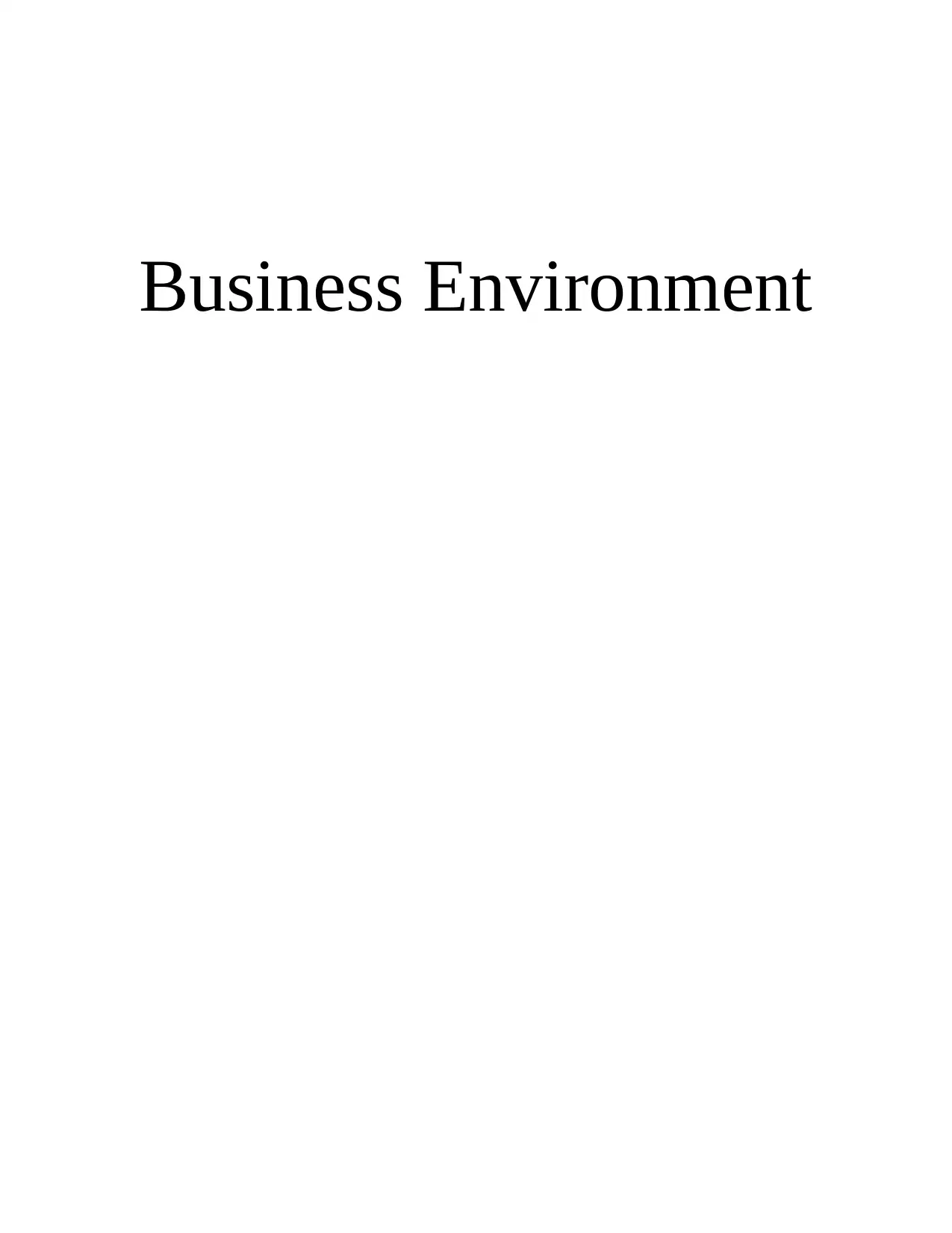
Business Environment
Paraphrase This Document
Need a fresh take? Get an instant paraphrase of this document with our AI Paraphraser
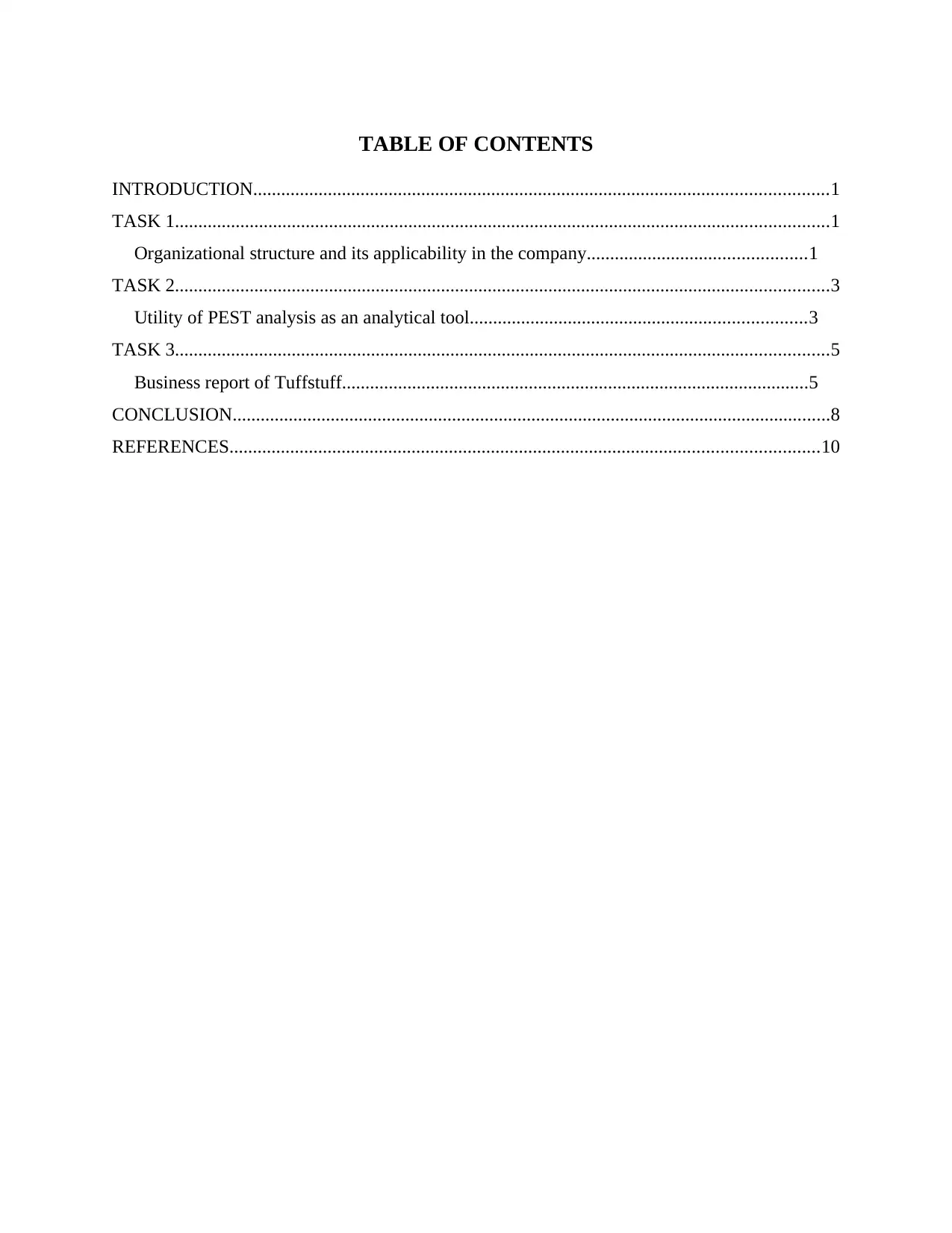
TABLE OF CONTENTS
INTRODUCTION...........................................................................................................................1
TASK 1............................................................................................................................................1
Organizational structure and its applicability in the company...............................................1
TASK 2............................................................................................................................................3
Utility of PEST analysis as an analytical tool........................................................................3
TASK 3............................................................................................................................................5
Business report of Tuffstuff....................................................................................................5
CONCLUSION................................................................................................................................8
REFERENCES..............................................................................................................................10
INTRODUCTION...........................................................................................................................1
TASK 1............................................................................................................................................1
Organizational structure and its applicability in the company...............................................1
TASK 2............................................................................................................................................3
Utility of PEST analysis as an analytical tool........................................................................3
TASK 3............................................................................................................................................5
Business report of Tuffstuff....................................................................................................5
CONCLUSION................................................................................................................................8
REFERENCES..............................................................................................................................10
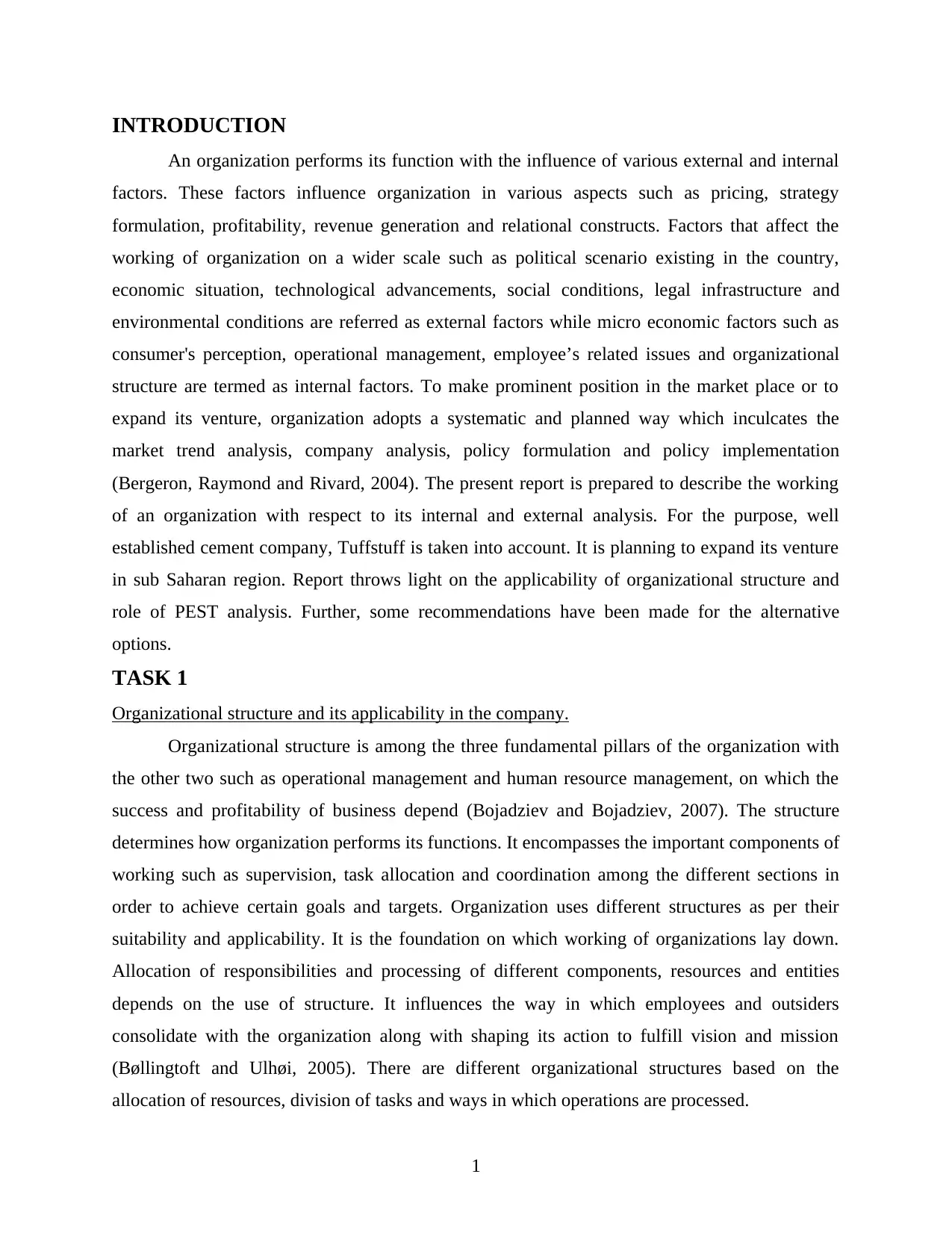
INTRODUCTION
An organization performs its function with the influence of various external and internal
factors. These factors influence organization in various aspects such as pricing, strategy
formulation, profitability, revenue generation and relational constructs. Factors that affect the
working of organization on a wider scale such as political scenario existing in the country,
economic situation, technological advancements, social conditions, legal infrastructure and
environmental conditions are referred as external factors while micro economic factors such as
consumer's perception, operational management, employee’s related issues and organizational
structure are termed as internal factors. To make prominent position in the market place or to
expand its venture, organization adopts a systematic and planned way which inculcates the
market trend analysis, company analysis, policy formulation and policy implementation
(Bergeron, Raymond and Rivard, 2004). The present report is prepared to describe the working
of an organization with respect to its internal and external analysis. For the purpose, well
established cement company, Tuffstuff is taken into account. It is planning to expand its venture
in sub Saharan region. Report throws light on the applicability of organizational structure and
role of PEST analysis. Further, some recommendations have been made for the alternative
options.
TASK 1
Organizational structure and its applicability in the company.
Organizational structure is among the three fundamental pillars of the organization with
the other two such as operational management and human resource management, on which the
success and profitability of business depend (Bojadziev and Bojadziev, 2007). The structure
determines how organization performs its functions. It encompasses the important components of
working such as supervision, task allocation and coordination among the different sections in
order to achieve certain goals and targets. Organization uses different structures as per their
suitability and applicability. It is the foundation on which working of organizations lay down.
Allocation of responsibilities and processing of different components, resources and entities
depends on the use of structure. It influences the way in which employees and outsiders
consolidate with the organization along with shaping its action to fulfill vision and mission
(Bøllingtoft and Ulhøi, 2005). There are different organizational structures based on the
allocation of resources, division of tasks and ways in which operations are processed.
1
An organization performs its function with the influence of various external and internal
factors. These factors influence organization in various aspects such as pricing, strategy
formulation, profitability, revenue generation and relational constructs. Factors that affect the
working of organization on a wider scale such as political scenario existing in the country,
economic situation, technological advancements, social conditions, legal infrastructure and
environmental conditions are referred as external factors while micro economic factors such as
consumer's perception, operational management, employee’s related issues and organizational
structure are termed as internal factors. To make prominent position in the market place or to
expand its venture, organization adopts a systematic and planned way which inculcates the
market trend analysis, company analysis, policy formulation and policy implementation
(Bergeron, Raymond and Rivard, 2004). The present report is prepared to describe the working
of an organization with respect to its internal and external analysis. For the purpose, well
established cement company, Tuffstuff is taken into account. It is planning to expand its venture
in sub Saharan region. Report throws light on the applicability of organizational structure and
role of PEST analysis. Further, some recommendations have been made for the alternative
options.
TASK 1
Organizational structure and its applicability in the company.
Organizational structure is among the three fundamental pillars of the organization with
the other two such as operational management and human resource management, on which the
success and profitability of business depend (Bojadziev and Bojadziev, 2007). The structure
determines how organization performs its functions. It encompasses the important components of
working such as supervision, task allocation and coordination among the different sections in
order to achieve certain goals and targets. Organization uses different structures as per their
suitability and applicability. It is the foundation on which working of organizations lay down.
Allocation of responsibilities and processing of different components, resources and entities
depends on the use of structure. It influences the way in which employees and outsiders
consolidate with the organization along with shaping its action to fulfill vision and mission
(Bøllingtoft and Ulhøi, 2005). There are different organizational structures based on the
allocation of resources, division of tasks and ways in which operations are processed.
1
⊘ This is a preview!⊘
Do you want full access?
Subscribe today to unlock all pages.

Trusted by 1+ million students worldwide
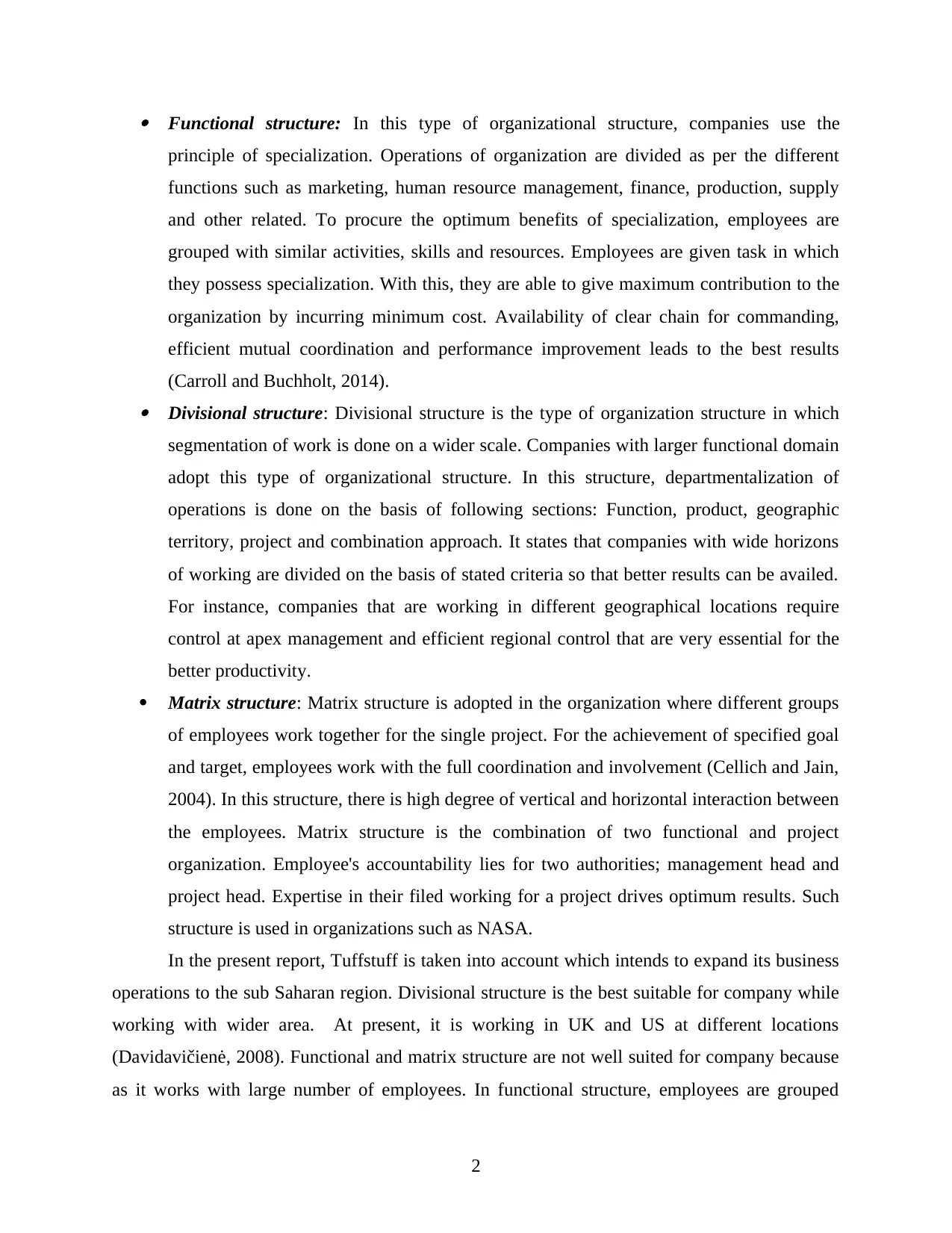
Functional structure: In this type of organizational structure, companies use the
principle of specialization. Operations of organization are divided as per the different
functions such as marketing, human resource management, finance, production, supply
and other related. To procure the optimum benefits of specialization, employees are
grouped with similar activities, skills and resources. Employees are given task in which
they possess specialization. With this, they are able to give maximum contribution to the
organization by incurring minimum cost. Availability of clear chain for commanding,
efficient mutual coordination and performance improvement leads to the best results
(Carroll and Buchholt, 2014). Divisional structure: Divisional structure is the type of organization structure in which
segmentation of work is done on a wider scale. Companies with larger functional domain
adopt this type of organizational structure. In this structure, departmentalization of
operations is done on the basis of following sections: Function, product, geographic
territory, project and combination approach. It states that companies with wide horizons
of working are divided on the basis of stated criteria so that better results can be availed.
For instance, companies that are working in different geographical locations require
control at apex management and efficient regional control that are very essential for the
better productivity.
Matrix structure: Matrix structure is adopted in the organization where different groups
of employees work together for the single project. For the achievement of specified goal
and target, employees work with the full coordination and involvement (Cellich and Jain,
2004). In this structure, there is high degree of vertical and horizontal interaction between
the employees. Matrix structure is the combination of two functional and project
organization. Employee's accountability lies for two authorities; management head and
project head. Expertise in their filed working for a project drives optimum results. Such
structure is used in organizations such as NASA.
In the present report, Tuffstuff is taken into account which intends to expand its business
operations to the sub Saharan region. Divisional structure is the best suitable for company while
working with wider area. At present, it is working in UK and US at different locations
(Davidavičienė, 2008). Functional and matrix structure are not well suited for company because
as it works with large number of employees. In functional structure, employees are grouped
2
principle of specialization. Operations of organization are divided as per the different
functions such as marketing, human resource management, finance, production, supply
and other related. To procure the optimum benefits of specialization, employees are
grouped with similar activities, skills and resources. Employees are given task in which
they possess specialization. With this, they are able to give maximum contribution to the
organization by incurring minimum cost. Availability of clear chain for commanding,
efficient mutual coordination and performance improvement leads to the best results
(Carroll and Buchholt, 2014). Divisional structure: Divisional structure is the type of organization structure in which
segmentation of work is done on a wider scale. Companies with larger functional domain
adopt this type of organizational structure. In this structure, departmentalization of
operations is done on the basis of following sections: Function, product, geographic
territory, project and combination approach. It states that companies with wide horizons
of working are divided on the basis of stated criteria so that better results can be availed.
For instance, companies that are working in different geographical locations require
control at apex management and efficient regional control that are very essential for the
better productivity.
Matrix structure: Matrix structure is adopted in the organization where different groups
of employees work together for the single project. For the achievement of specified goal
and target, employees work with the full coordination and involvement (Cellich and Jain,
2004). In this structure, there is high degree of vertical and horizontal interaction between
the employees. Matrix structure is the combination of two functional and project
organization. Employee's accountability lies for two authorities; management head and
project head. Expertise in their filed working for a project drives optimum results. Such
structure is used in organizations such as NASA.
In the present report, Tuffstuff is taken into account which intends to expand its business
operations to the sub Saharan region. Divisional structure is the best suitable for company while
working with wider area. At present, it is working in UK and US at different locations
(Davidavičienė, 2008). Functional and matrix structure are not well suited for company because
as it works with large number of employees. In functional structure, employees are grouped
2
Paraphrase This Document
Need a fresh take? Get an instant paraphrase of this document with our AI Paraphraser
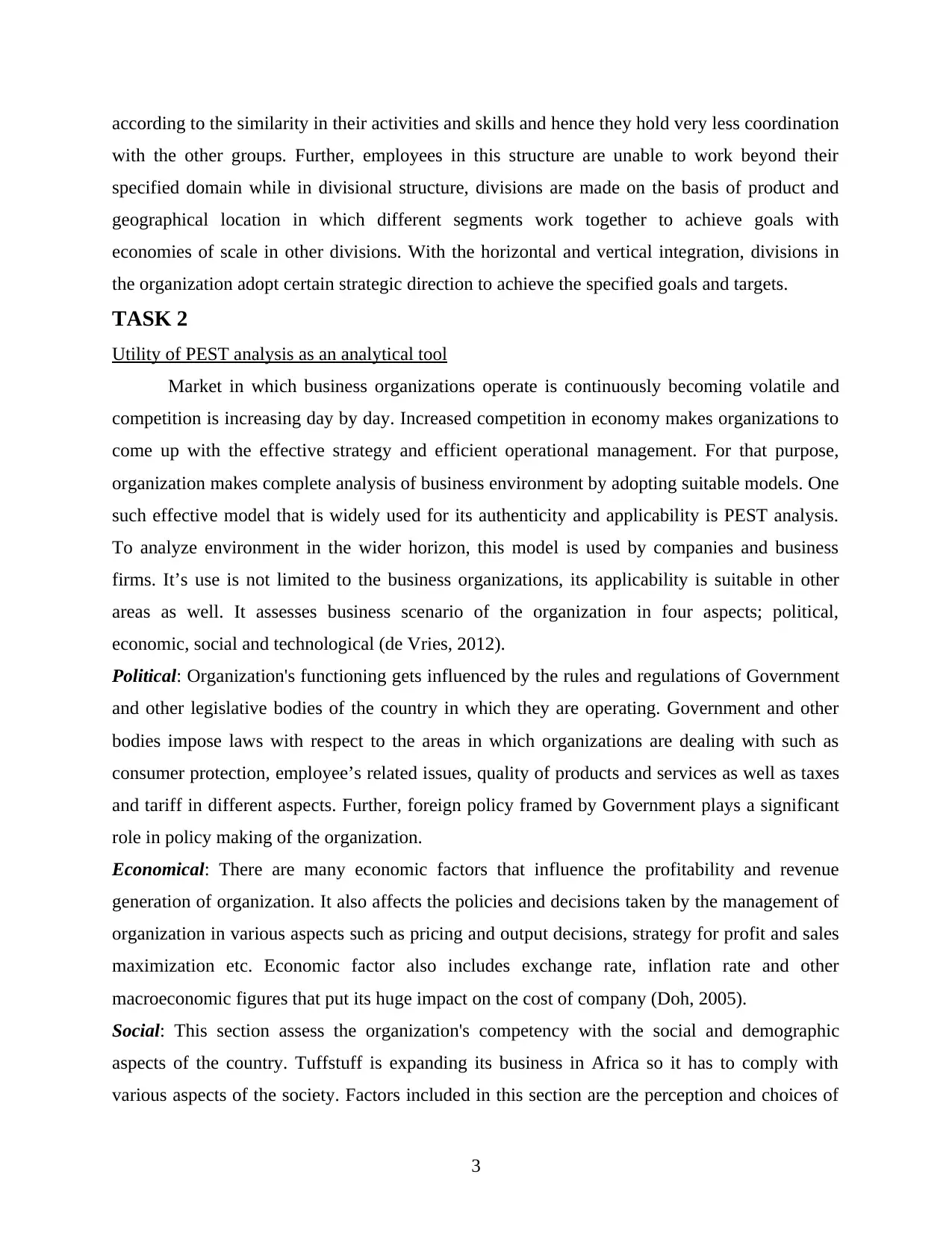
according to the similarity in their activities and skills and hence they hold very less coordination
with the other groups. Further, employees in this structure are unable to work beyond their
specified domain while in divisional structure, divisions are made on the basis of product and
geographical location in which different segments work together to achieve goals with
economies of scale in other divisions. With the horizontal and vertical integration, divisions in
the organization adopt certain strategic direction to achieve the specified goals and targets.
TASK 2
Utility of PEST analysis as an analytical tool
Market in which business organizations operate is continuously becoming volatile and
competition is increasing day by day. Increased competition in economy makes organizations to
come up with the effective strategy and efficient operational management. For that purpose,
organization makes complete analysis of business environment by adopting suitable models. One
such effective model that is widely used for its authenticity and applicability is PEST analysis.
To analyze environment in the wider horizon, this model is used by companies and business
firms. It’s use is not limited to the business organizations, its applicability is suitable in other
areas as well. It assesses business scenario of the organization in four aspects; political,
economic, social and technological (de Vries, 2012).
Political: Organization's functioning gets influenced by the rules and regulations of Government
and other legislative bodies of the country in which they are operating. Government and other
bodies impose laws with respect to the areas in which organizations are dealing with such as
consumer protection, employee’s related issues, quality of products and services as well as taxes
and tariff in different aspects. Further, foreign policy framed by Government plays a significant
role in policy making of the organization.
Economical: There are many economic factors that influence the profitability and revenue
generation of organization. It also affects the policies and decisions taken by the management of
organization in various aspects such as pricing and output decisions, strategy for profit and sales
maximization etc. Economic factor also includes exchange rate, inflation rate and other
macroeconomic figures that put its huge impact on the cost of company (Doh, 2005).
Social: This section assess the organization's competency with the social and demographic
aspects of the country. Tuffstuff is expanding its business in Africa so it has to comply with
various aspects of the society. Factors included in this section are the perception and choices of
3
with the other groups. Further, employees in this structure are unable to work beyond their
specified domain while in divisional structure, divisions are made on the basis of product and
geographical location in which different segments work together to achieve goals with
economies of scale in other divisions. With the horizontal and vertical integration, divisions in
the organization adopt certain strategic direction to achieve the specified goals and targets.
TASK 2
Utility of PEST analysis as an analytical tool
Market in which business organizations operate is continuously becoming volatile and
competition is increasing day by day. Increased competition in economy makes organizations to
come up with the effective strategy and efficient operational management. For that purpose,
organization makes complete analysis of business environment by adopting suitable models. One
such effective model that is widely used for its authenticity and applicability is PEST analysis.
To analyze environment in the wider horizon, this model is used by companies and business
firms. It’s use is not limited to the business organizations, its applicability is suitable in other
areas as well. It assesses business scenario of the organization in four aspects; political,
economic, social and technological (de Vries, 2012).
Political: Organization's functioning gets influenced by the rules and regulations of Government
and other legislative bodies of the country in which they are operating. Government and other
bodies impose laws with respect to the areas in which organizations are dealing with such as
consumer protection, employee’s related issues, quality of products and services as well as taxes
and tariff in different aspects. Further, foreign policy framed by Government plays a significant
role in policy making of the organization.
Economical: There are many economic factors that influence the profitability and revenue
generation of organization. It also affects the policies and decisions taken by the management of
organization in various aspects such as pricing and output decisions, strategy for profit and sales
maximization etc. Economic factor also includes exchange rate, inflation rate and other
macroeconomic figures that put its huge impact on the cost of company (Doh, 2005).
Social: This section assess the organization's competency with the social and demographic
aspects of the country. Tuffstuff is expanding its business in Africa so it has to comply with
various aspects of the society. Factors included in this section are the perception and choices of
3
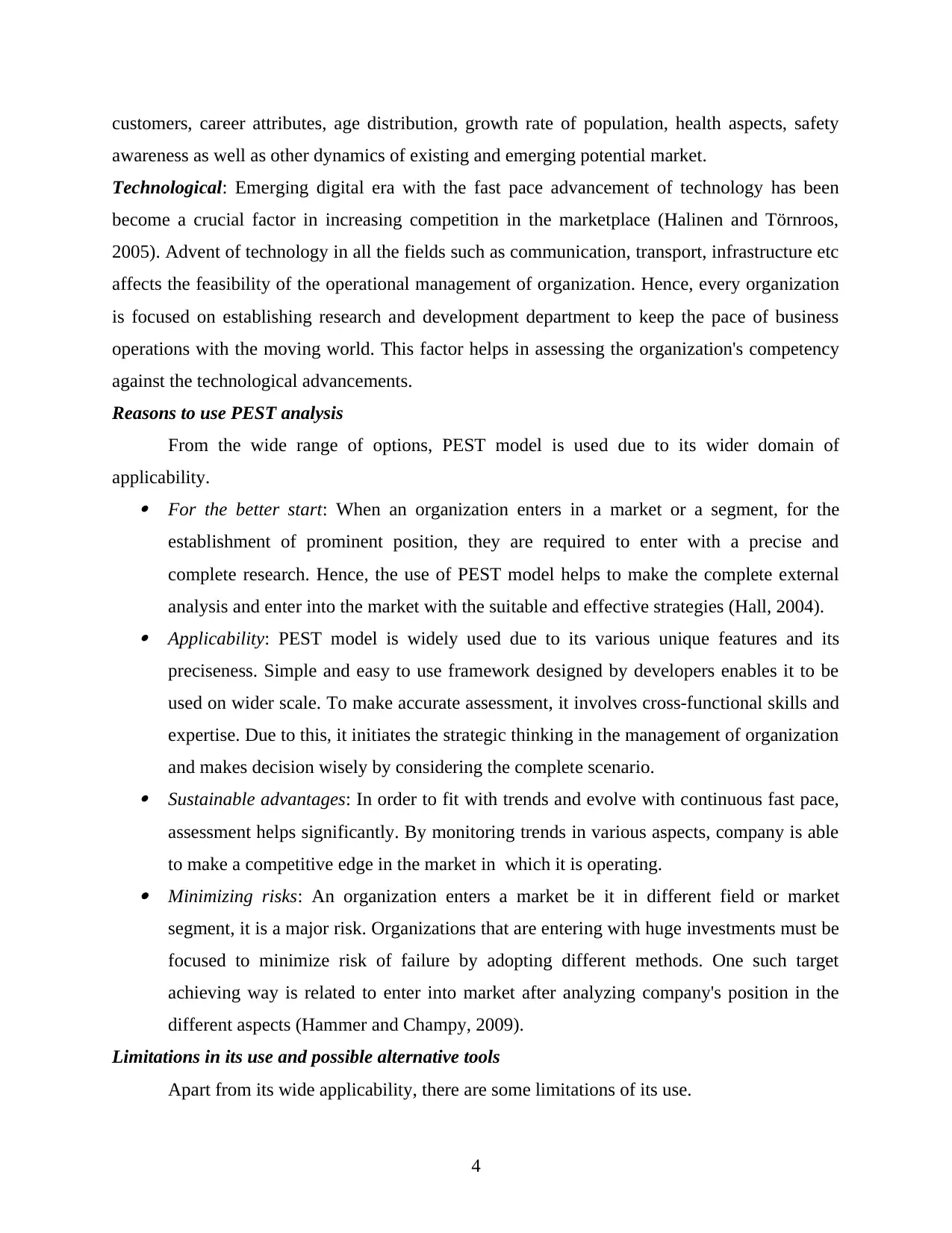
customers, career attributes, age distribution, growth rate of population, health aspects, safety
awareness as well as other dynamics of existing and emerging potential market.
Technological: Emerging digital era with the fast pace advancement of technology has been
become a crucial factor in increasing competition in the marketplace (Halinen and Törnroos,
2005). Advent of technology in all the fields such as communication, transport, infrastructure etc
affects the feasibility of the operational management of organization. Hence, every organization
is focused on establishing research and development department to keep the pace of business
operations with the moving world. This factor helps in assessing the organization's competency
against the technological advancements.
Reasons to use PEST analysis
From the wide range of options, PEST model is used due to its wider domain of
applicability. For the better start: When an organization enters in a market or a segment, for the
establishment of prominent position, they are required to enter with a precise and
complete research. Hence, the use of PEST model helps to make the complete external
analysis and enter into the market with the suitable and effective strategies (Hall, 2004). Applicability: PEST model is widely used due to its various unique features and its
preciseness. Simple and easy to use framework designed by developers enables it to be
used on wider scale. To make accurate assessment, it involves cross-functional skills and
expertise. Due to this, it initiates the strategic thinking in the management of organization
and makes decision wisely by considering the complete scenario. Sustainable advantages: In order to fit with trends and evolve with continuous fast pace,
assessment helps significantly. By monitoring trends in various aspects, company is able
to make a competitive edge in the market in which it is operating. Minimizing risks: An organization enters a market be it in different field or market
segment, it is a major risk. Organizations that are entering with huge investments must be
focused to minimize risk of failure by adopting different methods. One such target
achieving way is related to enter into market after analyzing company's position in the
different aspects (Hammer and Champy, 2009).
Limitations in its use and possible alternative tools
Apart from its wide applicability, there are some limitations of its use.
4
awareness as well as other dynamics of existing and emerging potential market.
Technological: Emerging digital era with the fast pace advancement of technology has been
become a crucial factor in increasing competition in the marketplace (Halinen and Törnroos,
2005). Advent of technology in all the fields such as communication, transport, infrastructure etc
affects the feasibility of the operational management of organization. Hence, every organization
is focused on establishing research and development department to keep the pace of business
operations with the moving world. This factor helps in assessing the organization's competency
against the technological advancements.
Reasons to use PEST analysis
From the wide range of options, PEST model is used due to its wider domain of
applicability. For the better start: When an organization enters in a market or a segment, for the
establishment of prominent position, they are required to enter with a precise and
complete research. Hence, the use of PEST model helps to make the complete external
analysis and enter into the market with the suitable and effective strategies (Hall, 2004). Applicability: PEST model is widely used due to its various unique features and its
preciseness. Simple and easy to use framework designed by developers enables it to be
used on wider scale. To make accurate assessment, it involves cross-functional skills and
expertise. Due to this, it initiates the strategic thinking in the management of organization
and makes decision wisely by considering the complete scenario. Sustainable advantages: In order to fit with trends and evolve with continuous fast pace,
assessment helps significantly. By monitoring trends in various aspects, company is able
to make a competitive edge in the market in which it is operating. Minimizing risks: An organization enters a market be it in different field or market
segment, it is a major risk. Organizations that are entering with huge investments must be
focused to minimize risk of failure by adopting different methods. One such target
achieving way is related to enter into market after analyzing company's position in the
different aspects (Hammer and Champy, 2009).
Limitations in its use and possible alternative tools
Apart from its wide applicability, there are some limitations of its use.
4
⊘ This is a preview!⊘
Do you want full access?
Subscribe today to unlock all pages.

Trusted by 1+ million students worldwide
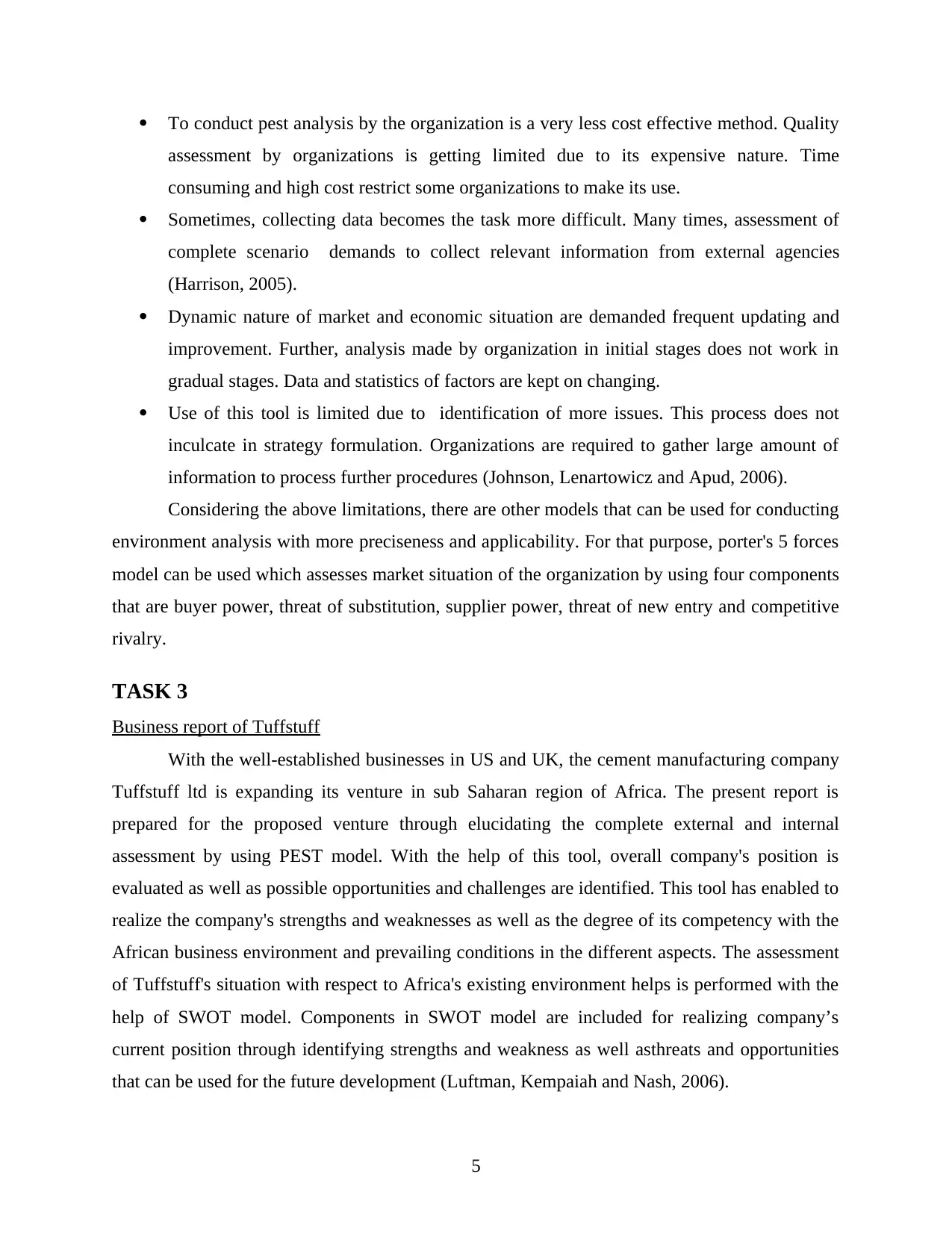
To conduct pest analysis by the organization is a very less cost effective method. Quality
assessment by organizations is getting limited due to its expensive nature. Time
consuming and high cost restrict some organizations to make its use.
Sometimes, collecting data becomes the task more difficult. Many times, assessment of
complete scenario demands to collect relevant information from external agencies
(Harrison, 2005).
Dynamic nature of market and economic situation are demanded frequent updating and
improvement. Further, analysis made by organization in initial stages does not work in
gradual stages. Data and statistics of factors are kept on changing.
Use of this tool is limited due to identification of more issues. This process does not
inculcate in strategy formulation. Organizations are required to gather large amount of
information to process further procedures (Johnson, Lenartowicz and Apud, 2006).
Considering the above limitations, there are other models that can be used for conducting
environment analysis with more preciseness and applicability. For that purpose, porter's 5 forces
model can be used which assesses market situation of the organization by using four components
that are buyer power, threat of substitution, supplier power, threat of new entry and competitive
rivalry.
TASK 3
Business report of Tuffstuff
With the well-established businesses in US and UK, the cement manufacturing company
Tuffstuff ltd is expanding its venture in sub Saharan region of Africa. The present report is
prepared for the proposed venture through elucidating the complete external and internal
assessment by using PEST model. With the help of this tool, overall company's position is
evaluated as well as possible opportunities and challenges are identified. This tool has enabled to
realize the company's strengths and weaknesses as well as the degree of its competency with the
African business environment and prevailing conditions in the different aspects. The assessment
of Tuffstuff's situation with respect to Africa's existing environment helps is performed with the
help of SWOT model. Components in SWOT model are included for realizing company’s
current position through identifying strengths and weakness as well asthreats and opportunities
that can be used for the future development (Luftman, Kempaiah and Nash, 2006).
5
assessment by organizations is getting limited due to its expensive nature. Time
consuming and high cost restrict some organizations to make its use.
Sometimes, collecting data becomes the task more difficult. Many times, assessment of
complete scenario demands to collect relevant information from external agencies
(Harrison, 2005).
Dynamic nature of market and economic situation are demanded frequent updating and
improvement. Further, analysis made by organization in initial stages does not work in
gradual stages. Data and statistics of factors are kept on changing.
Use of this tool is limited due to identification of more issues. This process does not
inculcate in strategy formulation. Organizations are required to gather large amount of
information to process further procedures (Johnson, Lenartowicz and Apud, 2006).
Considering the above limitations, there are other models that can be used for conducting
environment analysis with more preciseness and applicability. For that purpose, porter's 5 forces
model can be used which assesses market situation of the organization by using four components
that are buyer power, threat of substitution, supplier power, threat of new entry and competitive
rivalry.
TASK 3
Business report of Tuffstuff
With the well-established businesses in US and UK, the cement manufacturing company
Tuffstuff ltd is expanding its venture in sub Saharan region of Africa. The present report is
prepared for the proposed venture through elucidating the complete external and internal
assessment by using PEST model. With the help of this tool, overall company's position is
evaluated as well as possible opportunities and challenges are identified. This tool has enabled to
realize the company's strengths and weaknesses as well as the degree of its competency with the
African business environment and prevailing conditions in the different aspects. The assessment
of Tuffstuff's situation with respect to Africa's existing environment helps is performed with the
help of SWOT model. Components in SWOT model are included for realizing company’s
current position through identifying strengths and weakness as well asthreats and opportunities
that can be used for the future development (Luftman, Kempaiah and Nash, 2006).
5
Paraphrase This Document
Need a fresh take? Get an instant paraphrase of this document with our AI Paraphraser
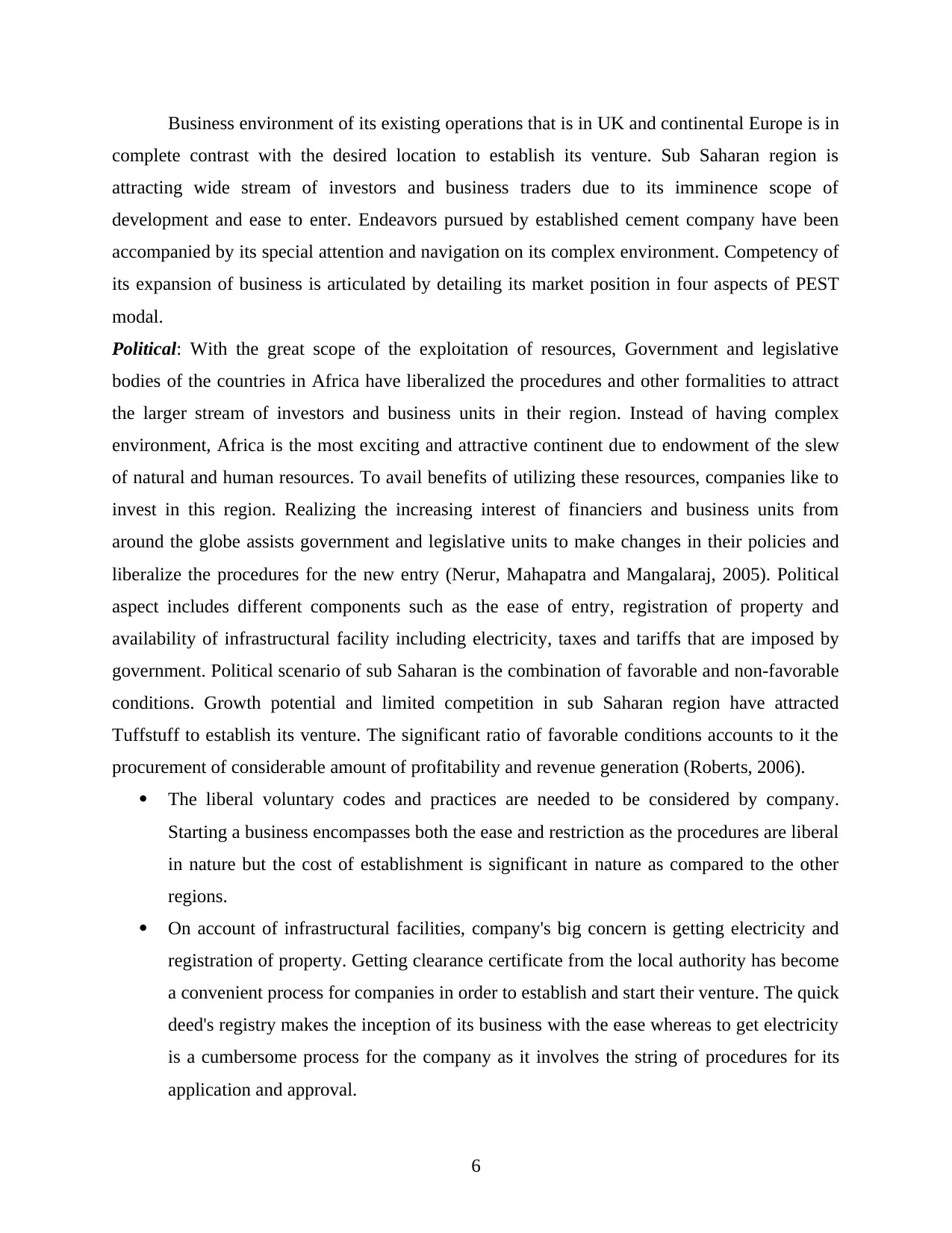
Business environment of its existing operations that is in UK and continental Europe is in
complete contrast with the desired location to establish its venture. Sub Saharan region is
attracting wide stream of investors and business traders due to its imminence scope of
development and ease to enter. Endeavors pursued by established cement company have been
accompanied by its special attention and navigation on its complex environment. Competency of
its expansion of business is articulated by detailing its market position in four aspects of PEST
modal.
Political: With the great scope of the exploitation of resources, Government and legislative
bodies of the countries in Africa have liberalized the procedures and other formalities to attract
the larger stream of investors and business units in their region. Instead of having complex
environment, Africa is the most exciting and attractive continent due to endowment of the slew
of natural and human resources. To avail benefits of utilizing these resources, companies like to
invest in this region. Realizing the increasing interest of financiers and business units from
around the globe assists government and legislative units to make changes in their policies and
liberalize the procedures for the new entry (Nerur, Mahapatra and Mangalaraj, 2005). Political
aspect includes different components such as the ease of entry, registration of property and
availability of infrastructural facility including electricity, taxes and tariffs that are imposed by
government. Political scenario of sub Saharan is the combination of favorable and non-favorable
conditions. Growth potential and limited competition in sub Saharan region have attracted
Tuffstuff to establish its venture. The significant ratio of favorable conditions accounts to it the
procurement of considerable amount of profitability and revenue generation (Roberts, 2006).
The liberal voluntary codes and practices are needed to be considered by company.
Starting a business encompasses both the ease and restriction as the procedures are liberal
in nature but the cost of establishment is significant in nature as compared to the other
regions.
On account of infrastructural facilities, company's big concern is getting electricity and
registration of property. Getting clearance certificate from the local authority has become
a convenient process for companies in order to establish and start their venture. The quick
deed's registry makes the inception of its business with the ease whereas to get electricity
is a cumbersome process for the company as it involves the string of procedures for its
application and approval.
6
complete contrast with the desired location to establish its venture. Sub Saharan region is
attracting wide stream of investors and business traders due to its imminence scope of
development and ease to enter. Endeavors pursued by established cement company have been
accompanied by its special attention and navigation on its complex environment. Competency of
its expansion of business is articulated by detailing its market position in four aspects of PEST
modal.
Political: With the great scope of the exploitation of resources, Government and legislative
bodies of the countries in Africa have liberalized the procedures and other formalities to attract
the larger stream of investors and business units in their region. Instead of having complex
environment, Africa is the most exciting and attractive continent due to endowment of the slew
of natural and human resources. To avail benefits of utilizing these resources, companies like to
invest in this region. Realizing the increasing interest of financiers and business units from
around the globe assists government and legislative units to make changes in their policies and
liberalize the procedures for the new entry (Nerur, Mahapatra and Mangalaraj, 2005). Political
aspect includes different components such as the ease of entry, registration of property and
availability of infrastructural facility including electricity, taxes and tariffs that are imposed by
government. Political scenario of sub Saharan is the combination of favorable and non-favorable
conditions. Growth potential and limited competition in sub Saharan region have attracted
Tuffstuff to establish its venture. The significant ratio of favorable conditions accounts to it the
procurement of considerable amount of profitability and revenue generation (Roberts, 2006).
The liberal voluntary codes and practices are needed to be considered by company.
Starting a business encompasses both the ease and restriction as the procedures are liberal
in nature but the cost of establishment is significant in nature as compared to the other
regions.
On account of infrastructural facilities, company's big concern is getting electricity and
registration of property. Getting clearance certificate from the local authority has become
a convenient process for companies in order to establish and start their venture. The quick
deed's registry makes the inception of its business with the ease whereas to get electricity
is a cumbersome process for the company as it involves the string of procedures for its
application and approval.
6
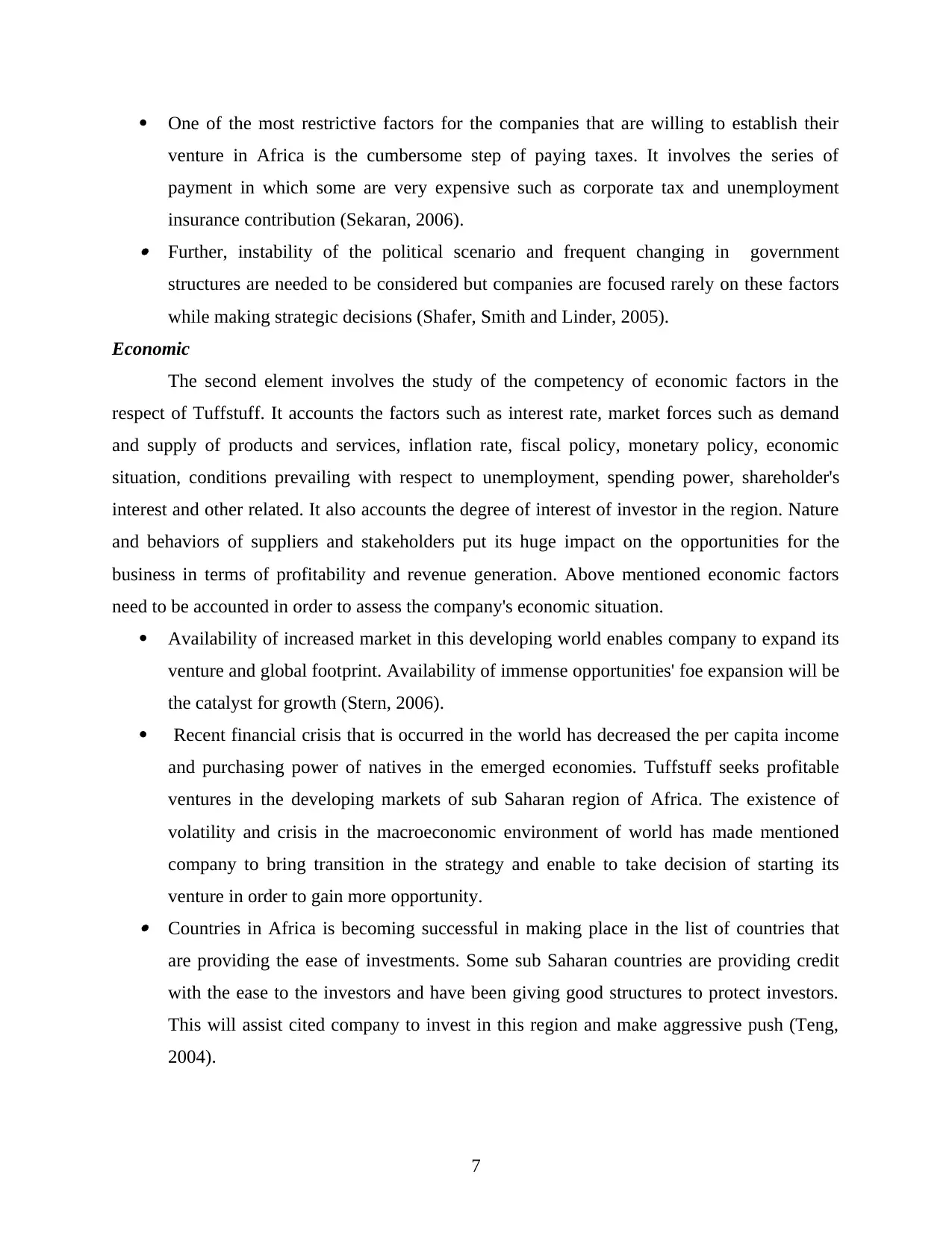
One of the most restrictive factors for the companies that are willing to establish their
venture in Africa is the cumbersome step of paying taxes. It involves the series of
payment in which some are very expensive such as corporate tax and unemployment
insurance contribution (Sekaran, 2006). Further, instability of the political scenario and frequent changing in government
structures are needed to be considered but companies are focused rarely on these factors
while making strategic decisions (Shafer, Smith and Linder, 2005).
Economic
The second element involves the study of the competency of economic factors in the
respect of Tuffstuff. It accounts the factors such as interest rate, market forces such as demand
and supply of products and services, inflation rate, fiscal policy, monetary policy, economic
situation, conditions prevailing with respect to unemployment, spending power, shareholder's
interest and other related. It also accounts the degree of interest of investor in the region. Nature
and behaviors of suppliers and stakeholders put its huge impact on the opportunities for the
business in terms of profitability and revenue generation. Above mentioned economic factors
need to be accounted in order to assess the company's economic situation.
Availability of increased market in this developing world enables company to expand its
venture and global footprint. Availability of immense opportunities' foe expansion will be
the catalyst for growth (Stern, 2006).
Recent financial crisis that is occurred in the world has decreased the per capita income
and purchasing power of natives in the emerged economies. Tuffstuff seeks profitable
ventures in the developing markets of sub Saharan region of Africa. The existence of
volatility and crisis in the macroeconomic environment of world has made mentioned
company to bring transition in the strategy and enable to take decision of starting its
venture in order to gain more opportunity. Countries in Africa is becoming successful in making place in the list of countries that
are providing the ease of investments. Some sub Saharan countries are providing credit
with the ease to the investors and have been giving good structures to protect investors.
This will assist cited company to invest in this region and make aggressive push (Teng,
2004).
7
venture in Africa is the cumbersome step of paying taxes. It involves the series of
payment in which some are very expensive such as corporate tax and unemployment
insurance contribution (Sekaran, 2006). Further, instability of the political scenario and frequent changing in government
structures are needed to be considered but companies are focused rarely on these factors
while making strategic decisions (Shafer, Smith and Linder, 2005).
Economic
The second element involves the study of the competency of economic factors in the
respect of Tuffstuff. It accounts the factors such as interest rate, market forces such as demand
and supply of products and services, inflation rate, fiscal policy, monetary policy, economic
situation, conditions prevailing with respect to unemployment, spending power, shareholder's
interest and other related. It also accounts the degree of interest of investor in the region. Nature
and behaviors of suppliers and stakeholders put its huge impact on the opportunities for the
business in terms of profitability and revenue generation. Above mentioned economic factors
need to be accounted in order to assess the company's economic situation.
Availability of increased market in this developing world enables company to expand its
venture and global footprint. Availability of immense opportunities' foe expansion will be
the catalyst for growth (Stern, 2006).
Recent financial crisis that is occurred in the world has decreased the per capita income
and purchasing power of natives in the emerged economies. Tuffstuff seeks profitable
ventures in the developing markets of sub Saharan region of Africa. The existence of
volatility and crisis in the macroeconomic environment of world has made mentioned
company to bring transition in the strategy and enable to take decision of starting its
venture in order to gain more opportunity. Countries in Africa is becoming successful in making place in the list of countries that
are providing the ease of investments. Some sub Saharan countries are providing credit
with the ease to the investors and have been giving good structures to protect investors.
This will assist cited company to invest in this region and make aggressive push (Teng,
2004).
7
⊘ This is a preview!⊘
Do you want full access?
Subscribe today to unlock all pages.

Trusted by 1+ million students worldwide
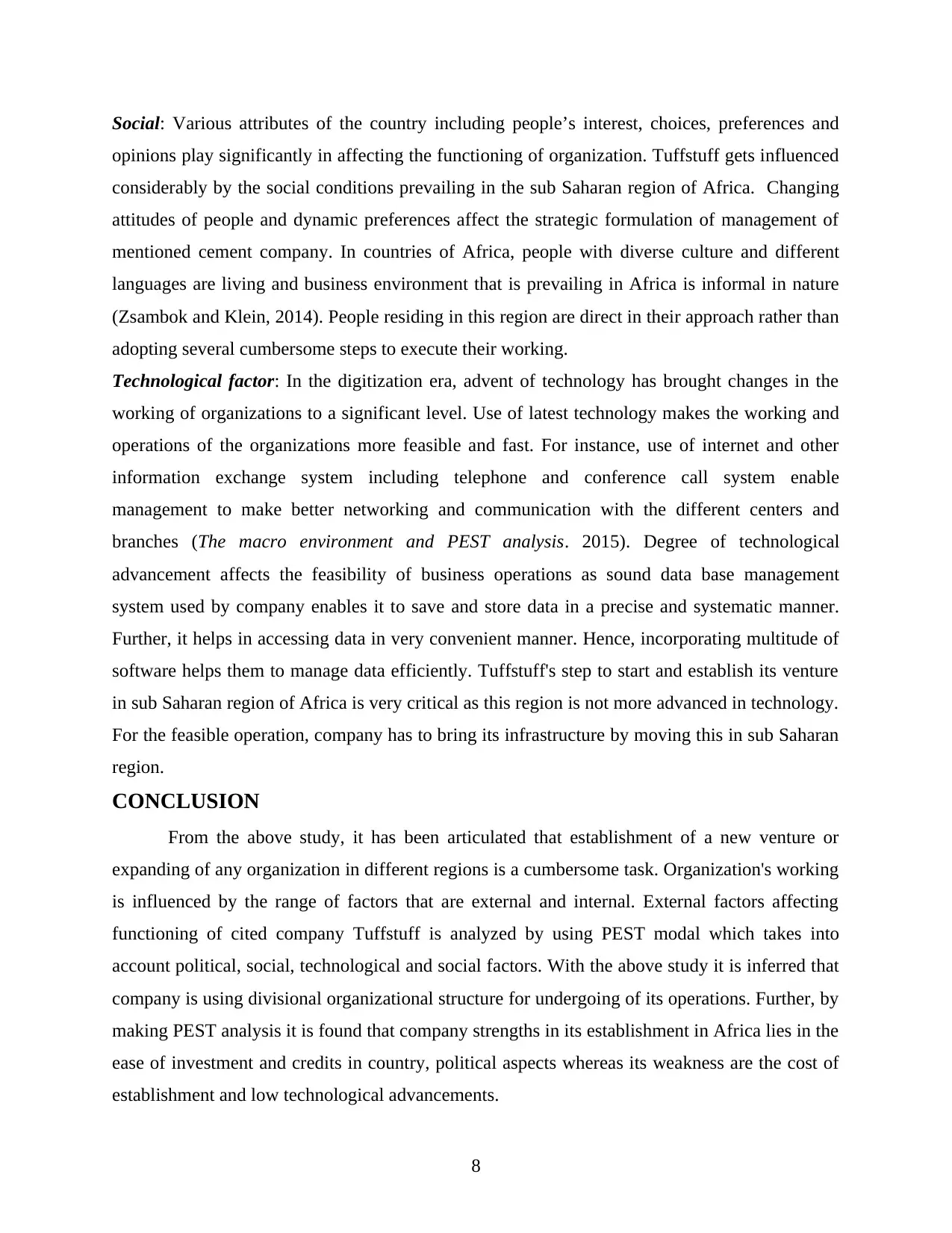
Social: Various attributes of the country including people’s interest, choices, preferences and
opinions play significantly in affecting the functioning of organization. Tuffstuff gets influenced
considerably by the social conditions prevailing in the sub Saharan region of Africa. Changing
attitudes of people and dynamic preferences affect the strategic formulation of management of
mentioned cement company. In countries of Africa, people with diverse culture and different
languages are living and business environment that is prevailing in Africa is informal in nature
(Zsambok and Klein, 2014). People residing in this region are direct in their approach rather than
adopting several cumbersome steps to execute their working.
Technological factor: In the digitization era, advent of technology has brought changes in the
working of organizations to a significant level. Use of latest technology makes the working and
operations of the organizations more feasible and fast. For instance, use of internet and other
information exchange system including telephone and conference call system enable
management to make better networking and communication with the different centers and
branches (The macro environment and PEST analysis. 2015). Degree of technological
advancement affects the feasibility of business operations as sound data base management
system used by company enables it to save and store data in a precise and systematic manner.
Further, it helps in accessing data in very convenient manner. Hence, incorporating multitude of
software helps them to manage data efficiently. Tuffstuff's step to start and establish its venture
in sub Saharan region of Africa is very critical as this region is not more advanced in technology.
For the feasible operation, company has to bring its infrastructure by moving this in sub Saharan
region.
CONCLUSION
From the above study, it has been articulated that establishment of a new venture or
expanding of any organization in different regions is a cumbersome task. Organization's working
is influenced by the range of factors that are external and internal. External factors affecting
functioning of cited company Tuffstuff is analyzed by using PEST modal which takes into
account political, social, technological and social factors. With the above study it is inferred that
company is using divisional organizational structure for undergoing of its operations. Further, by
making PEST analysis it is found that company strengths in its establishment in Africa lies in the
ease of investment and credits in country, political aspects whereas its weakness are the cost of
establishment and low technological advancements.
8
opinions play significantly in affecting the functioning of organization. Tuffstuff gets influenced
considerably by the social conditions prevailing in the sub Saharan region of Africa. Changing
attitudes of people and dynamic preferences affect the strategic formulation of management of
mentioned cement company. In countries of Africa, people with diverse culture and different
languages are living and business environment that is prevailing in Africa is informal in nature
(Zsambok and Klein, 2014). People residing in this region are direct in their approach rather than
adopting several cumbersome steps to execute their working.
Technological factor: In the digitization era, advent of technology has brought changes in the
working of organizations to a significant level. Use of latest technology makes the working and
operations of the organizations more feasible and fast. For instance, use of internet and other
information exchange system including telephone and conference call system enable
management to make better networking and communication with the different centers and
branches (The macro environment and PEST analysis. 2015). Degree of technological
advancement affects the feasibility of business operations as sound data base management
system used by company enables it to save and store data in a precise and systematic manner.
Further, it helps in accessing data in very convenient manner. Hence, incorporating multitude of
software helps them to manage data efficiently. Tuffstuff's step to start and establish its venture
in sub Saharan region of Africa is very critical as this region is not more advanced in technology.
For the feasible operation, company has to bring its infrastructure by moving this in sub Saharan
region.
CONCLUSION
From the above study, it has been articulated that establishment of a new venture or
expanding of any organization in different regions is a cumbersome task. Organization's working
is influenced by the range of factors that are external and internal. External factors affecting
functioning of cited company Tuffstuff is analyzed by using PEST modal which takes into
account political, social, technological and social factors. With the above study it is inferred that
company is using divisional organizational structure for undergoing of its operations. Further, by
making PEST analysis it is found that company strengths in its establishment in Africa lies in the
ease of investment and credits in country, political aspects whereas its weakness are the cost of
establishment and low technological advancements.
8
Paraphrase This Document
Need a fresh take? Get an instant paraphrase of this document with our AI Paraphraser
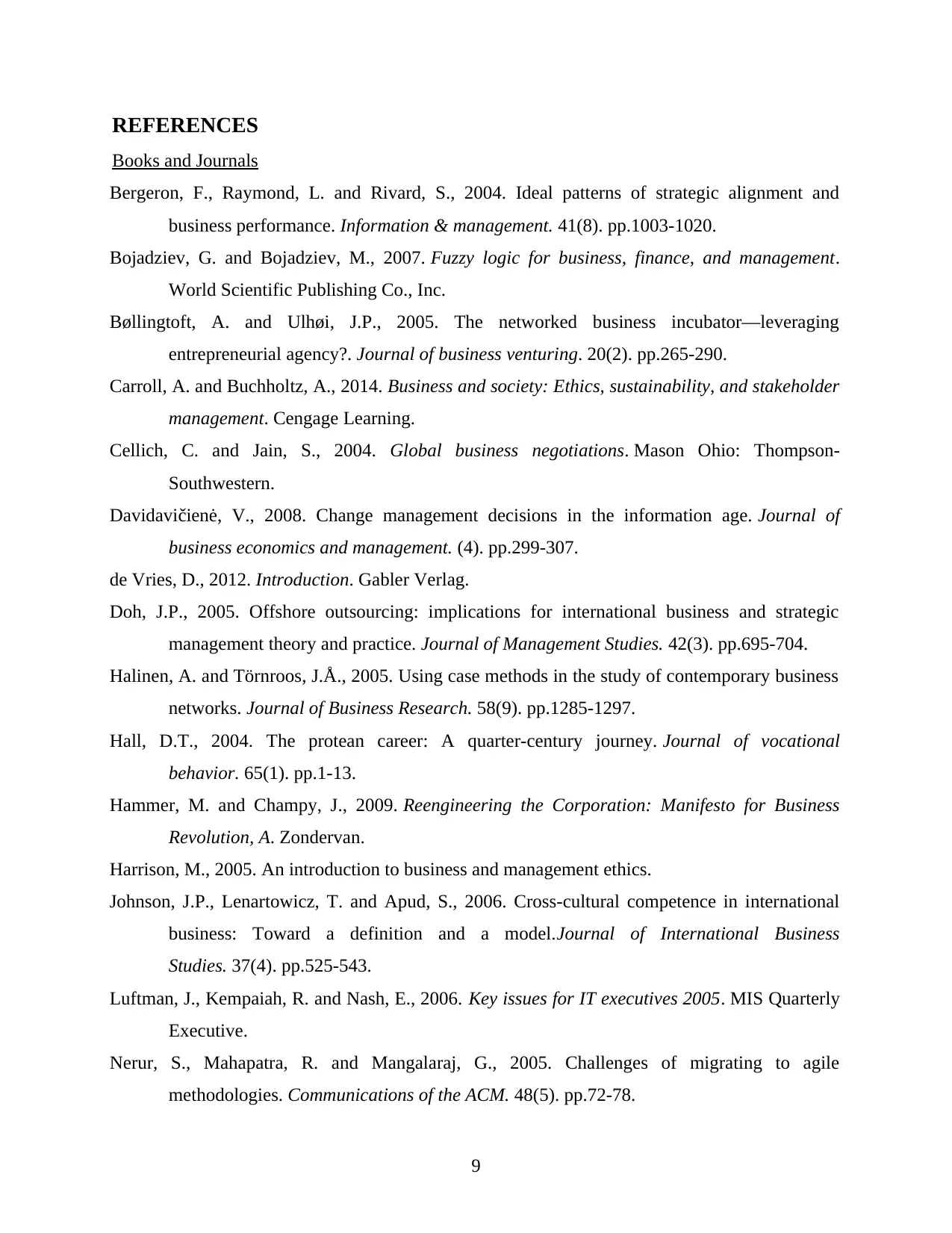
REFERENCES
Books and Journals
Bergeron, F., Raymond, L. and Rivard, S., 2004. Ideal patterns of strategic alignment and
business performance. Information & management. 41(8). pp.1003-1020.
Bojadziev, G. and Bojadziev, M., 2007. Fuzzy logic for business, finance, and management.
World Scientific Publishing Co., Inc.
Bøllingtoft, A. and Ulhøi, J.P., 2005. The networked business incubator—leveraging
entrepreneurial agency?. Journal of business venturing. 20(2). pp.265-290.
Carroll, A. and Buchholtz, A., 2014. Business and society: Ethics, sustainability, and stakeholder
management. Cengage Learning.
Cellich, C. and Jain, S., 2004. Global business negotiations. Mason Ohio: Thompson-
Southwestern.
Davidavičienė, V., 2008. Change management decisions in the information age. Journal of
business economics and management. (4). pp.299-307.
de Vries, D., 2012. Introduction. Gabler Verlag.
Doh, J.P., 2005. Offshore outsourcing: implications for international business and strategic
management theory and practice. Journal of Management Studies. 42(3). pp.695-704.
Halinen, A. and Törnroos, J.Å., 2005. Using case methods in the study of contemporary business
networks. Journal of Business Research. 58(9). pp.1285-1297.
Hall, D.T., 2004. The protean career: A quarter-century journey. Journal of vocational
behavior. 65(1). pp.1-13.
Hammer, M. and Champy, J., 2009. Reengineering the Corporation: Manifesto for Business
Revolution, A. Zondervan.
Harrison, M., 2005. An introduction to business and management ethics.
Johnson, J.P., Lenartowicz, T. and Apud, S., 2006. Cross-cultural competence in international
business: Toward a definition and a model.Journal of International Business
Studies. 37(4). pp.525-543.
Luftman, J., Kempaiah, R. and Nash, E., 2006. Key issues for IT executives 2005. MIS Quarterly
Executive.
Nerur, S., Mahapatra, R. and Mangalaraj, G., 2005. Challenges of migrating to agile
methodologies. Communications of the ACM. 48(5). pp.72-78.
9
Books and Journals
Bergeron, F., Raymond, L. and Rivard, S., 2004. Ideal patterns of strategic alignment and
business performance. Information & management. 41(8). pp.1003-1020.
Bojadziev, G. and Bojadziev, M., 2007. Fuzzy logic for business, finance, and management.
World Scientific Publishing Co., Inc.
Bøllingtoft, A. and Ulhøi, J.P., 2005. The networked business incubator—leveraging
entrepreneurial agency?. Journal of business venturing. 20(2). pp.265-290.
Carroll, A. and Buchholtz, A., 2014. Business and society: Ethics, sustainability, and stakeholder
management. Cengage Learning.
Cellich, C. and Jain, S., 2004. Global business negotiations. Mason Ohio: Thompson-
Southwestern.
Davidavičienė, V., 2008. Change management decisions in the information age. Journal of
business economics and management. (4). pp.299-307.
de Vries, D., 2012. Introduction. Gabler Verlag.
Doh, J.P., 2005. Offshore outsourcing: implications for international business and strategic
management theory and practice. Journal of Management Studies. 42(3). pp.695-704.
Halinen, A. and Törnroos, J.Å., 2005. Using case methods in the study of contemporary business
networks. Journal of Business Research. 58(9). pp.1285-1297.
Hall, D.T., 2004. The protean career: A quarter-century journey. Journal of vocational
behavior. 65(1). pp.1-13.
Hammer, M. and Champy, J., 2009. Reengineering the Corporation: Manifesto for Business
Revolution, A. Zondervan.
Harrison, M., 2005. An introduction to business and management ethics.
Johnson, J.P., Lenartowicz, T. and Apud, S., 2006. Cross-cultural competence in international
business: Toward a definition and a model.Journal of International Business
Studies. 37(4). pp.525-543.
Luftman, J., Kempaiah, R. and Nash, E., 2006. Key issues for IT executives 2005. MIS Quarterly
Executive.
Nerur, S., Mahapatra, R. and Mangalaraj, G., 2005. Challenges of migrating to agile
methodologies. Communications of the ACM. 48(5). pp.72-78.
9
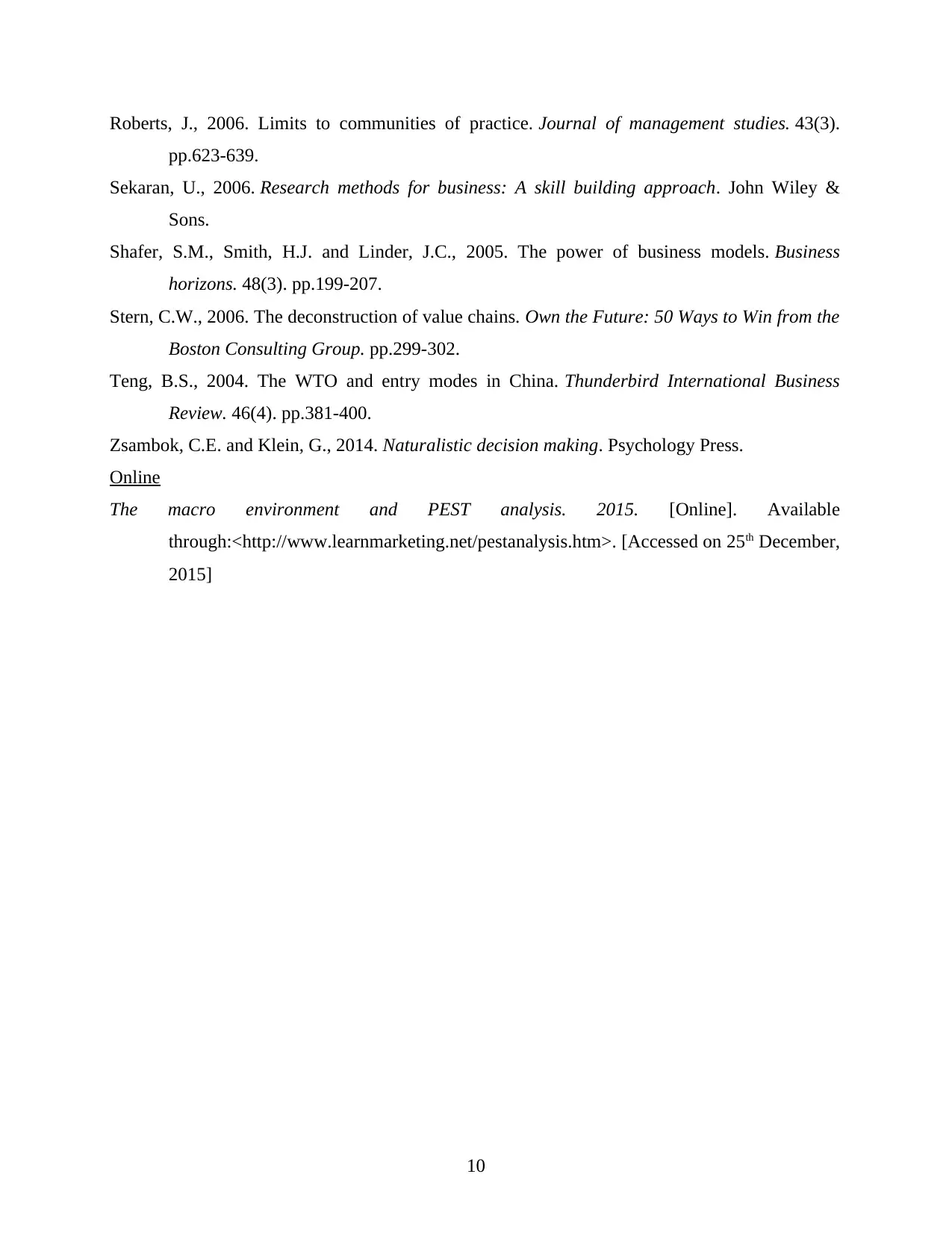
Roberts, J., 2006. Limits to communities of practice. Journal of management studies. 43(3).
pp.623-639.
Sekaran, U., 2006. Research methods for business: A skill building approach. John Wiley &
Sons.
Shafer, S.M., Smith, H.J. and Linder, J.C., 2005. The power of business models. Business
horizons. 48(3). pp.199-207.
Stern, C.W., 2006. The deconstruction of value chains. Own the Future: 50 Ways to Win from the
Boston Consulting Group. pp.299-302.
Teng, B.S., 2004. The WTO and entry modes in China. Thunderbird International Business
Review. 46(4). pp.381-400.
Zsambok, C.E. and Klein, G., 2014. Naturalistic decision making. Psychology Press.
Online
The macro environment and PEST analysis. 2015. [Online]. Available
through:<http://www.learnmarketing.net/pestanalysis.htm>. [Accessed on 25th December,
2015]
10
pp.623-639.
Sekaran, U., 2006. Research methods for business: A skill building approach. John Wiley &
Sons.
Shafer, S.M., Smith, H.J. and Linder, J.C., 2005. The power of business models. Business
horizons. 48(3). pp.199-207.
Stern, C.W., 2006. The deconstruction of value chains. Own the Future: 50 Ways to Win from the
Boston Consulting Group. pp.299-302.
Teng, B.S., 2004. The WTO and entry modes in China. Thunderbird International Business
Review. 46(4). pp.381-400.
Zsambok, C.E. and Klein, G., 2014. Naturalistic decision making. Psychology Press.
Online
The macro environment and PEST analysis. 2015. [Online]. Available
through:<http://www.learnmarketing.net/pestanalysis.htm>. [Accessed on 25th December,
2015]
10
⊘ This is a preview!⊘
Do you want full access?
Subscribe today to unlock all pages.

Trusted by 1+ million students worldwide
1 out of 12
Related Documents
Your All-in-One AI-Powered Toolkit for Academic Success.
+13062052269
info@desklib.com
Available 24*7 on WhatsApp / Email
![[object Object]](/_next/static/media/star-bottom.7253800d.svg)
Unlock your academic potential
Copyright © 2020–2025 A2Z Services. All Rights Reserved. Developed and managed by ZUCOL.





